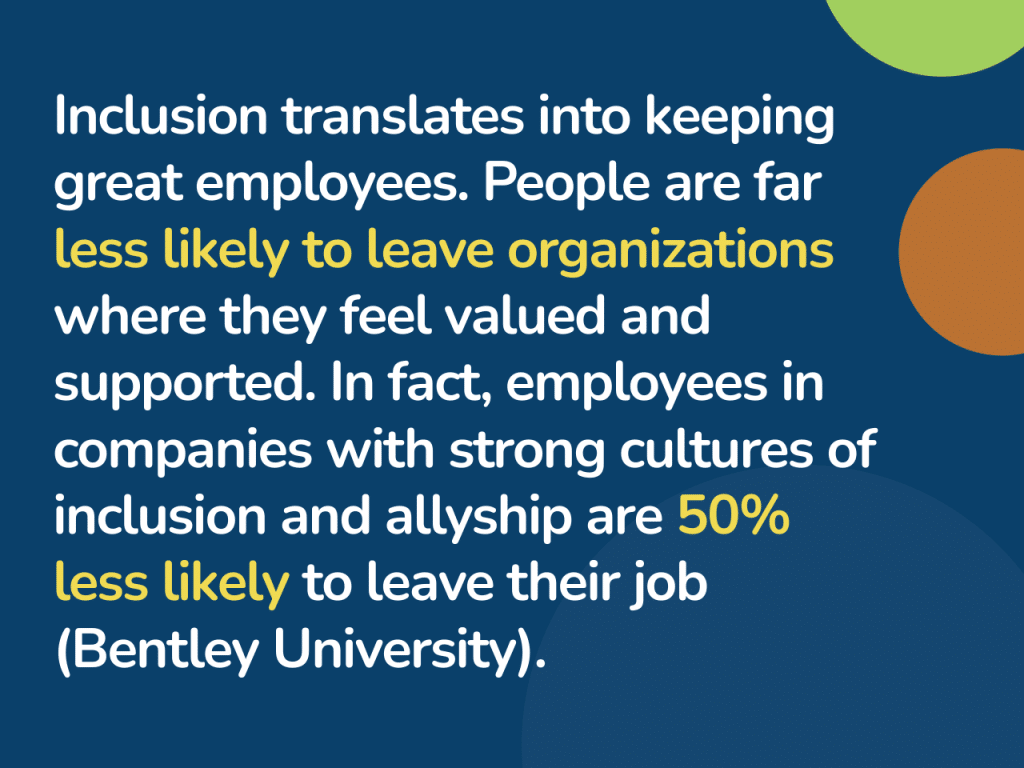Creating an Inclusive Work Environment Through Allyship: A Strategic Advantage
When we celebrate the unique identities of what each person brings to the table, we unlock their full performance that define high-performing teams.
Table of Content
Recognizing the differences among your people in the workplace is only the beginning. To really start unlocking your team’s potential, those differences must be embraced, celebrated, and embedded into the culture of how we work. In today’s world, inclusion is no longer optional, it’s essential.

Hiring diverse talent is a vital first step, but true inclusion happens in what follows after that talent walks in the doors on their first day. Leaders must take intentional, ongoing action to ensure that every team member feels safe, respected, valued, and supported. When people feel a genuine sense of belonging, they do their best work. Inclusive cultures drive engagement, spark innovation, and strengthen collaboration across teams.
Inclusion is more than a value – it’s a competitive advantage. Today’s top talent seeks organizations that lead with authenticity, purpose, and belonging. Inclusive workplaces don’t just attract strong candidates; they retain and elevate them to be the next generation of leaders. When we celebrate the unique identities and perspectives each person brings to the table, we unlock the full creativity, productivity, and performance that define high-performing teams. Just ask anyone who’s been part of one – they’ll tell you: it makes all the difference.
One of the most powerful—and often overlooked—drivers of inclusion is allyship.
Allyship is a critical component of fostering an inclusive workplace. It refers to the active, ongoing practice of supporting and advocating for colleagues from all underrepresented groups. True allyship involves more than just having good intentions; it requires identifying and removing barriers, challenging systemic inequities, and cultivating an organizational culture grounded in empathy, equity, and respect for all people.
Being an effective ally isn’t always easy. It requires humility, self-awareness, continual learning – and most importantly, action. It calls on us to listen deeply, examine our own biases, and remain committed even when – especially when – the path is uncomfortable.
Here’s the truth: lasting, meaningful change relies on allies. For those navigating systemic challenges, the presence of colleagues who are willing to step up, speak out, and stand beside them can be nothing short of transformational.

As a leader, you carry a massive amount of both influence and responsibility. It’s not enough to quietly support inclusion, you must actively lead it. That means using your platform, your privilege, and your position to advocate for all team members, regardless of their background or identity. Allyship must be reflected not just in what you say, but in what you do – in decisions, policies, and daily interactions.
This Pride Month, we’ll hear a lot about allyship in the context of the LGBTQ+ community – and rightly so. As someone whose personal journey is deeply connected to this community, I feel that message deeply. But it’s essential to remember: allyship isn’t limited to one group. It extends to anyone who has been historically marginalized – due to race, gender identity, disability, socioeconomic background, or any other aspect of identity.
Leaders play a critical role in ensuring inclusion isn’t just a seasonal initiative or a checkbox – it must be a consistent, visible, and evolving priority every month out of the year. Our role and duty is to foster environments where people feel safe to speak up, confident to share their ideas, and empowered to be their full, authentic selves.
When leaders model allyship, they don’t just create better workplaces – they create workplaces where better work happens.

Creating a culture of allyship requires consistent, intentional, and authentic action. Here are some practical ways leaders can weave allyship into their teams and organizations:
When truly embraced, these actions can drive innovation, build trust, and strengthen your culture from the inside out.
Building an inclusive workplace is deeply rewarding—but like everything worth doing, it’s not without its challenges. Unconscious bias, outdated systems, and structural inequities can create real barriers. Overcoming them requires real work and follow-through.
Leaders can take action by:
These aren’t one-time actions; they’re ongoing commitments that help make allyship a lived value, not just a buzzword.
Creating an inclusive workplace isn’t just a moral imperative – it’s a business one. When leaders commit to allyship and inclusion, they build environments where people feel seen, heard, and empowered to thrive.
That commitment drives performance, attracts top-talent, and strengthens your organization’s long-term future and all of these can positively impact the bottom line. More importantly, it helps shape a workplace – and a world – where everyone has a fair opportunity to grow, contribute, and lead.
Your leadership sets the tone. Show up with intention, lead with authenticity, and never stop learning. The impact will ripple far beyond your team.
Talk to us about how Velosio can help you realize business value faster with end-to-end solutions and cloud services.